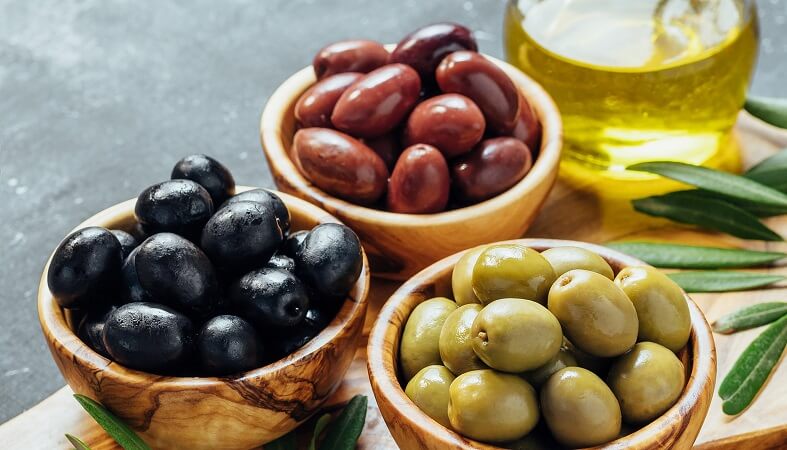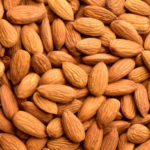Dear Readers, Olives are a Mediterranean delicacy and at the same time very healthy. Consumed regularly, the small stone fruit has numerous healthy effects on your body. In the following, you will find out everything worth knowing about the olive and what you should pay attention to when using it.
The positive properties of olive oil have long been known, but what about the olives themselves? Green, purple, and black olives not only taste different, but they also have different amounts of calories and nutrients. They all have health effects, so they should not be missing from your diet.
Interesting facts about olives
Whether on pizza, in a salad, or as a snack – olives are part of Mediterranean cuisine and give many dishes a unique taste. The most popular varieties are the green Manzanilla and black Kalamata olives. You can now find out what you should know about the drupe and what you need to watch out for during pregnancy.
Where Olives Come From
Olives are the fruit of the olive tree. They have an oblong or round shape and can grow up to four centimeters. Even if the taste is more reminiscent of a vegetable, they are considered a fruit.
The olive tree finds ideal conditions in the Mediterranean region, which is why particularly tasty olives are grown in Spain, Italy, and Greece, for example. There are said to be several hundred or even a thousand different varieties worldwide, the exact number is not known. Depending on the variety, the taste is bitter, sour, sweet, or salty.
Because of the high-fat content, the fruits are particularly suitable for the production of cooking oil. About ninety percent of the harvest is processed into olive oil, the rest is eaten raw.
Difference between green and black olives
Green and black olives are the same fruit the different color depends solely on the degree of ripeness. Green olives are the unripe fruits of the olive tree, while black ones are ripe.
Ripe olives are not always completely black, they often shimmer dark red or purple depending on the degree of ripeness. They are softer and taste savory and aromatic. Green olives are harvested earlier and have a fruity, slightly sour taste.
Both green and black olives are inedible straight from the tree due to their bitter taste. Therefore, they are usually pickled in brine or oil, which gives them a pleasant taste.
Popular olive varieties
The most popular olive in the world is the Green Manzanilla, originally from Spain. Translated, Manzanilla means “little apple”, which indicates the shape. It is rather small and medium firm.
Due to its tart, yet mild aroma, it is perfect as an addition to an aperitif. In addition, it is often filled with almond sticks, peppers, or anchovy paste.
Another very popular variety is the Kalamata Olive. It comes from the Greek region of Kalamata on the Peloponnese peninsula and has an aromatic pulp.
The almond-shaped appearance and the reddish-brown, violet, or black color are characteristic. Compared to other varieties, their skin is a little firmer.
Why olives are healthy
Olives are real powerhouses and contain many healthy vitamins, minerals, and phytochemicals. They are low in carbohydrates and their fat is high in unsaturated fatty acids, making them very healthy food.
The color also affects the nutrients. Ripe black olives have a higher content and are richer in unsaturated fatty acids.
Green olives contain more water and are more digestible due to the higher proportion of bitter substances. With an increasing degree of ripeness, the valuable oleuropein, which is responsible for the bitter taste, decreases. This active ingredient is one of the most effective natural antioxidants and has numerous health effects.
Green and black olives contain these healthy nutrients:
- Minerals and trace elements such as phosphorus, sodium, calcium, iron, and magnesium.
- Vitamin B1, B2, B6, E, folic acid and beta-carotene
- Secondary plant substances such as polyphenols, for example, oleuropein
Fresh olives are not necessarily healthier than fruit from a jar. Also preserved in brine, lemon juice, or oil, they have a high nutrient content and are rich in unsaturated fatty acids.
How many calories are in olives
The calorie content depends on the degree of ripeness. Black olives have a higher fat content and are richer than green olives.
100 grams of green olives have around 140 kilocalories, while black ones can have twice as many calories, depending on the variety and degree of ripeness. If they are preserved in oil, the fat content and the calories also increase.
Black olives have more fiber and higher protein content than green olives. The nutritional value table on the packaging shows you the exact values.
Because blackened olives are actually green olives, they have fewer calories than naturally ripened black fruit.
What you have to consider during pregnancy
Contrary to popular belief, you can eat olives while pregnant. However, you should note a few things so as not to endanger the health of your unborn child.
Don’t buy openly sold products at the deli counter as you don’t know anything about the hygienic standards of the producer. The same applies to stuffed olives with raw milk cheese, as they can be contaminated with listeria. Infection poses a serious risk to your unborn child.
You can eat hygienically packaged and non-stuffed olives without hesitation and benefit from the rich nutrients. However, keep the opened product in the refrigerator and do not leave it for longer than 7 days.
Healthy Effects of Olives
Olives naturally contain many valuable ingredients. That is why they are said to have numerous health effects. In the following, we will show you which diseases consumption can help you with.
Protection against heart attack and stroke
Olives are rich in unsaturated fatty acids. They contain the so-called oleic acid, which has an anti-inflammatory effect and, together with secondary plant substances, the polyphenols, ensures a lowering of the cholesterol level.
A distinction is made between good cholesterol (HDL) and bad cholesterol (LDL). Regular consumption of olives has been shown to reduce bad cholesterol, which can be the cause of cardiovascular diseases such as heart attacks and strokes. The drupe also lowers high blood pressure.
The phenols it contains make the blood vessels more flexible and thereby improve blood circulation. They prevent arterial calcification, which can offer you additional protection against coronary diseases.
Antioxidants can reduce cancer risk and wrinkles
Polyphenols are phytochemicals that are abundant in olives. These antioxidants have protective and health-promoting effects when you get them from food.
Researchers assume that healthy foods such as olives can reduce the risk of cancer. The contained polyphenols are anti-inflammatory and counteract cell stress caused by free radicals.
Free radicals are predatory oxygen compounds that enter your body and damage cells. This damage plays an important role in the development of cancer and skin aging, for example.
Antioxidants slow down the effects of free radical damage. The polyphenols of the olive, especially the bitter substance oleuropein, are said to inhibit the growth of cancer cells and lead to a lower mortality rate.
Green olives have a particularly high content of oleuropein, which studies have shown is also effective against bacteria, viruses, parasites, and high blood pressure. The active ingredient also dilates the vessels, promotes the cardiovascular system, lowers blood sugar, and strengthens the immune system.
Prevention of diabetes, intestinal diseases, and Alzheimer’s
Diseases such as type 2 diabetes, Alzheimer’s, and Crohn’s disease are usually preceded by long-lasting inflammatory processes.
The oleic acid contained in olives and the antioxidants have an anti-inflammatory effect and can make an important contribution to the prevention of these serious diseases.
Researchers have found that the polyphenols it contains can have the same anti-inflammatory effect as ibuprofen.
The bitter substances also stimulate your digestive organs and have a slightly appetizing effect. They stimulate the activity of your bile, which improves your digestion.
Help with rheumatism
Studies have shown that olives are healthy and can relieve the symptoms of rheumatoid arthritis.
With this painful condition, your immune system attacks its own cells, causing inflammation. As the disease progresses, the joints become swollen and deformed.
The unsaturated fatty acids of the drupe have an anti-inflammatory effect and can reduce the inflammation levels of rheumatism patients. This leads to an alleviation of the symptoms. In combination with omega-3 fatty acids, the effect is particularly high.
Vitamins strengthen eyesight, cell renewal, and nerves
The high vitamin content also makes olives healthy. The drupe contains, among other things, the vitamins B1, B2, B6, E, folic acid, and beta-carotene.
Vitamin B1 ensures the normal functioning of the nervous system, the heart, and the psyche. The growth of vitamin B2 supports energy metabolism and is responsible for maintaining the blood cells. Vitamin B6 contributes to the maintenance of vision and the function of the nervous system, and it also regulates hormonal balance.
Vitamin E plays an important role in cell renewal, it is also important for your immune system and reduces inflammation. Because it scavenges free radicals, it has a positive impact on your skin.
Folic acid is involved in many bodily processes, for example in cell division, formation, and renewal. It is also involve in blood formation. This vitamin is especially important during pregnancy.
The contained beta-carotene, also known as provitamin A, has a positive effect on your eyesight. It also contributes significantly to heart health and prevents inflammation and oxidative stress.
Important usage tips
Olives are healthy and give many dishes that special something thanks to their unique taste. Our tips will tell you what to look out for when using it.
Buy olives without additives
Black olives often turn out to be a sham after looking at the list of ingredients. Because there are many products available in the supermarket are chemically blackened to simulate the ripening of the fruit.
Green and black olives are the same fruit, only the increasing degree of ripeness causes the darker color. Selling green olives is more profitable for producers because the fruit has a shorter ripening period and the whole harvest can be done at once. They are also stronger and therefore more suitable for transport.
You can tell whether olives have been blackened by looking at the label or, in the case of open products, on the sign on the counter.
These additives consider harmless to health, but further processing can result in the formation of the pollutant acrylamide. This happens above all when the stone fruits are blackened under the influence of oxygen and later heated in order to preserve them in tins or jars, for example.
Acrylamide is suspected of being carcinogenic. In product tests of blackened olives, very high levels of acrylamide were sometimes detected. By buying naturally ripened fruit, you are playing it safe.
Eat seven olives a day
Numerous studies have shown that small stone fruits are healthy. To benefit from the positive ingredients, you should eat an average of seven olives a day.
In Spain, due to the ideal climate, there are not only countless olive trees, here the stone fruit officially considers to be beneficial to health. Due to the many health effects, the society for basic and applied nutritional science there issued the recommendation to eat seven olives a day.
Do not overheat olives
In order not to destroy the many valuable ingredients, you must not heat the olives too much. You may know this recommendation from olive oil, which you should also not heat above 180 degrees when cooking and frying. Naturally cloudy oils have an even lower smoke point and should therefore not be heated.
If you fry olives at high heat, the healthy antioxidants are destroyed. It is therefore better to heat the fruit briefly at the end or to eat it cold.
Pay attention to the salt content
Olives naturally contain a lot of salt. To preserve them, they are often placed in brine, which further increases the salt content.
Too much salt is harmful and can increase your blood pressure over time. Therefore, when buying, pay attention to the salt content, which can differ significantly. Product tests have shown that drupes can contain between one and thirteen grams of salt per hundred grams. The average is between three and six grams.
This is what matters when pickling olives
The fresh fruits of the olive tree are inedible because of the bitter taste. After harvesting, you should soak them in salt water for several weeks or months to make them edible. Black olives lose some of their bitter substances when they ripen on the tree and have to be stored for a shorter period of time.
In conventional production, it is common for olives to be debittered with caustic soda in a much shorter time, but the aroma and quality suffer as a result. Pickling in brine is gentler and provides better flavor.
The next step is to rinse the drupes and place them in either fresh brine or oil. To refine the taste, you can add vinegar, lemon, herbs, or garlic, for example. The fruits preserving by acetic acid or lactic acid, which produces by spontaneous fermentation, or by sterilization.













Leave a Reply